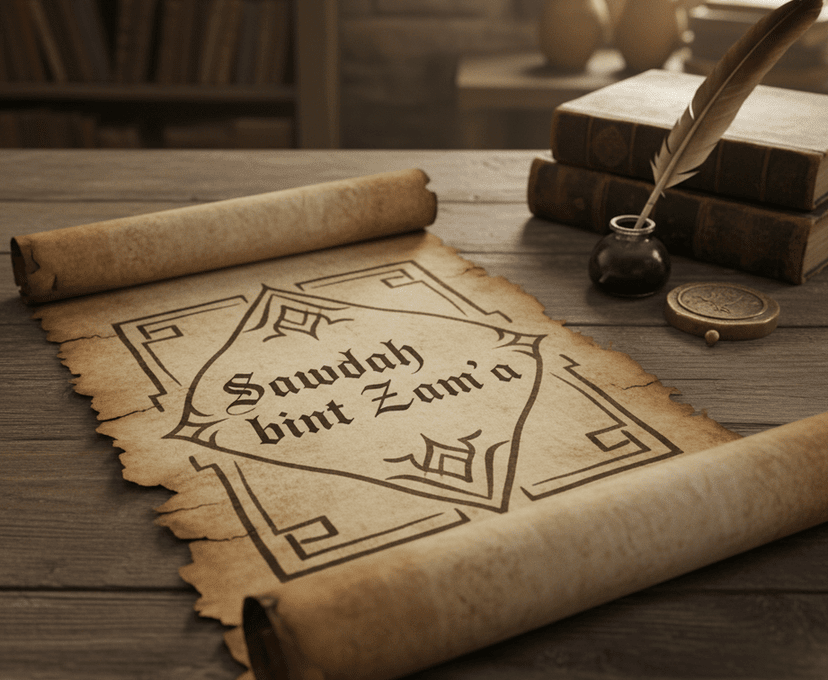Sawdah bint Zam’a was one of the most respected and steadfast women in early Islamic history, famously known as the second wife of the Prophet Muhammad (peace be upon him) and honored with the title “Umm-ul-Mu’mineen” (Mother of the Believers). Her life portrays profound faith, resilience, and loyalty, serving as an exemplar of dedication and sacrifice in Islam. This extensive content explores her biography, early life, migration, marriage to the Prophet, and her contributions with a conclusion and SEO-optimized FAQs.
Sawdah bint Zam’a

Sawdah bint Zam’a was born in Mecca in pre-Islamic Arabia within the noble Quraysh tribe, specifically from the Banu Amir ibn Lu’ayy clan. Her father was Zam’ah ibn Qays and her mother, Al-Shumus bint Qays, was from the Khazraj tribe of Medina. Exact details regarding her birth year vary, with estimates ranging roughly between 556 and 580 CE, making her notably older than some of the other wives of the Prophet.
Before her marriage to the Prophet Muhammad, Sawdah was married to her cousin As-Sakran ibn Amr, an early convert to Islam. Together, they had children, including Abdur Rahman and Abd ibn as-Sakran. Her husband was among the early Muslims who faced persecution in Mecca and participated in the early migration to Abyssinia (modern-day Ethiopia) to escape this oppression.
Early Conversion and Migration
Sawdah was among the earliest women to embrace Islam, demonstrating faith and courage during a time when converting often resulted in social ostracization, economic hardship, and physical danger. Alongside her husband, she undertook the significant and perilous migration—Hijra—to Abyssinia, seeking refuge under the Christian King Negus. This migration stands as a testament to her commitment and bravery, as it involved crossing the Red Sea to a foreign land purely for the sake of faith.
They lived in Abyssinia for several years before rumors of Meccan acceptance of Islam prompted their return. Tragically, shortly after their return, As-Sakran died, leaving Sawdah a widow.
Marriage to the Prophet Muhammad (PBUH)
After the death of Khadijah bint Khuwaylid (may Allah be pleased with her), the Prophet Muhammad experienced profound grief and loneliness. Recognizing his need for a caretaker for his household and his daughter Fatimah, his close companion Khawlah bint Hakim advised him to marry a mature, conscious woman who could manage domestic affairs. Khawlah recommended Sawdah, known for her faithfulness and steadiness, while also suggesting Aisha (may Allah be pleased with her) as a younger wife for companionship and healing the Prophet’s sorrow.
The Prophet married Sawdah around the tenth year after his prophethood, during Ramadan. Sawdah immediately took responsibility for caring for the Prophet’s household and his daughter Fatimah. She is described as a practical, pious woman whose age and experience provided comfort and stability to the Prophet’s family during a difficult period.
Her Character and Contributions
Sawdah bint Zam’a is known for her humor, kindness, and strong sense of loyalty. Despite her advanced age at the time of marriage, she was a vital support to the Prophet (PBUH) and part of the inner circle of Mothers of the Believers. She used her sharp wit to uplift the Prophet’s spirits when he was distressed, once making a joke that made him laugh heartily.
Her bravery as a Muhajirah (female migrant) during the early Islamic period, willingness to serve the community, and dedication to Islam’s cause have earned her a permanent place in Islamic history. She managed household affairs with grace and humility and supported the nascent Muslim community with unwavering faith.
Read more: mothers of believers in islam
Later Life and Legacy
Sawdah continued to live a dignified life, participating in community events and remaining steadfast in her faith until her death. Her story, though less publicized than some of the other wives of the Prophet, reflects endurance, faith under struggle, and profound service to Islam.
She is respected for her role in the early Muslim community as both a nurturer and a committed believer, representing a vital link in the history of Islam’s foundational period. Her legacy endures in Muslim memory as a symbol of loyalty, courage, and quiet strength.
FAQs
Who was Sawdah bint Zam'a?
Sawdah bint Zam'a was the second wife of Prophet Muhammad (PBUH), known as one of the Mothers of the Believers. She was an early convert to Islam and one of the first women to migrate to Abyssinia to escape persecution.
When did Sawdah bint Zam'a marry the Prophet Muhammad?
She married the Prophet Muhammad in the tenth year after his prophethood, shortly after the death of his first wife Khadijah, during Ramadan.
What was Sawdah’s role in the Prophet’s household?
Sawdah took care of the household and the Prophet’s daughter Fatimah. She helped provide maternal care and managed domestic affairs with devotion and dignity.
What makes Sawdah bint Zam'a an important figure in Islam?
She exemplified faith, resilience, and sacrifice by migrating for Islam, supporting the Prophet’s family, and standing firm during difficult times. Her life teaches dedication and humility in service to faith.
Did Sawdah have children?
Yes, Sawdah had children from her first marriage to As-Sakran ibn Amr, including Abdur Rahman and Abd ibn as-Sakran, but she had no children with the Prophet Muhammad.
Conclusion
Sawdah bint Zam’a’s life is a remarkable example of unwavering faith, resilience, and dedication. As one of the earliest converts and migrants, she faced formidable challenges with courage and composed strength. Her marriage to the Prophet Muhammad (PBUH) after the loss of Khadijah brought maternal care and stability to the Prophet’s household, illustrating the profound role women played in supporting Islam’s spread and consolidation. Sawdah’s story inspires Muslims today to embody faith with humility, loyalty with grace, and service with perseverance.

